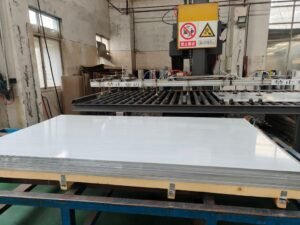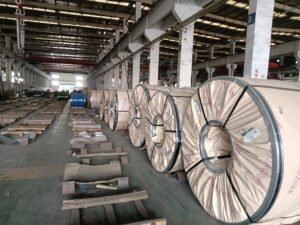Introduction
Finding reliable, high-quality carbon steel from China in 2025 can feel like navigating a maze. With risks of substandard materials, compliance issues, and supply chain delays, businesses in manufacturing and construction often struggle to secure suppliers they can trust for consistent results.
That’s where a strategic approach to sourcing comes in. This guide breaks down the essentials of selecting suppliers, verifying quality, and ensuring compliance with international standards. You’ll gain actionable insights to streamline your process, avoid costly QC issues, and build a robust supply chain for carbon steel imports.
Introduction to Carbon Steel and Its Importance in Industry
Welcome to the world of carbon steel, a material that forms the backbone of countless industries. This alloy, made primarily of iron and carbon, is prized for its strength and versatility. Whether you’re in manufacturing or construction, understanding carbon steel is key to making informed sourcing decisions, especially from thriving markets like China.
Let’s break it down. Carbon steel’s properties vary based on its carbon content, which impacts its durability and flexibility. These carbon steel properties make it suitable for everything from heavy machinery to structural beams, driving its demand globally.
What is Carbon Steel? Definition and Composition Basics
At its core, carbon steel is an alloy where carbon is the main alloying element with iron. The carbon content typically ranges from 0.05% to 2.0%, influencing its hardness and strength. This simple yet powerful composition allows for a wide range of applications in industrial settings.
Types of Carbon Steel: Low, Medium, and High Carbon Variants
Carbon steel comes in three main types based on carbon content. Low carbon steel, with less than 0.3% carbon, is softer and ideal for wiring or piping. Medium and high carbon variants, with up to 2.0% carbon, offer greater strength for tools and structural components.
Key Applications in Manufacturing and Construction Sectors
From skyscrapers to automotive parts, carbon steel is everywhere. Its adaptability allows it to meet strict carbon steel standards in construction for beams and rebar, while in manufacturing, it’s used for machinery and tools. This widespread use underscores its critical role in modern industry.
Why Source Carbon Steel from China? Market Overview for 2025
China dominates the global steel market with its vast supply capacity and cost-effectiveness. For businesses wondering how to source quality carbon steel from China, the market in 2025 promises advanced production capabilities and competitive pricing. Partnering with reliable suppliers like HnL Steel ensures access to quality products with a focus on compliance and efficiency.
The Chinese market isn’t just about volume; it’s about value. With an emphasis on meeting international standards, suppliers in China are increasingly focusing on quality assurance. This makes it a strategic hub for businesses aiming to balance cost and reliability.
Speaking of reliability, working with a trusted partner can make the process smooth as butter, or as we say, a “no-brainer”. HnL Steel, for instance, offers not just products but also expertise in navigating sourcing challenges. Their commitment to long-term partnerships ensures you’re covered at every step.
Carbon steel’s strength and versatility make it indispensable for industries like construction and manufacturing, especially when sourced cost-effectively from China.
Carbon Steel Usage Across Industries
| Industry | Primary Use | Carbon Steel Type | Annual Demand (Million Tons) | Quality Benchmark |
|---|---|---|---|---|
| Construction | Structural Beams | Medium Carbon | 150 | ASTM A36 |
| Automotive | Body Panels | Low Carbon | 80 | ISO 3574 |
| Manufacturing | Machinery Parts | High Carbon | 60 | SAE J403 |
| Energy | Pipelines | Medium Carbon | 40 | API 5L |
| Infrastructure | Bridges | Medium Carbon | 30 | EN 10025 |
Note: Annual demand data is based on 2023 global steel reports from World Steel Association, adjusted for projected trends in 2025. Quality benchmarks refer to widely accepted international standards ensuring material reliability. This data highlights why specific carbon steel types are chosen for each sector based on strength and compliance needs.
Mastering Supplier Selection for Carbon Steel Sourcing
Finding the right supplier for carbon steel can make or break your business operations. With China being a global leader in steel production, sourcing carbon steel from this market offers immense potential—but only if you choose wisely. This chapter walks you through the essential steps to pick reliable partners for long-term success.
Selecting quality carbon steel suppliers isn’t just about price; it’s about trust and consistency. You need a supplier who aligns with your goals and delivers on promises. Let’s explore the key factors that should guide your decision-making process in this competitive landscape.
Key Criteria for Choosing Suppliers: Honesty, Experience, and Track Record
Start by prioritizing honesty in your supplier relationships. Look for companies with a proven track record and years of experience in the industry. A supplier like HnL Steel, which emphasizes ‘Honest Longterm STEEL business with you,’ sets a strong example of integrity and reliability.
Assessing Supplier Certifications and Manufacturing Capabilities
Certifications are non-negotiable when sourcing from China. Ensure your supplier meets international standards like ISO or ASTM, which guarantee quality and safety. Additionally, evaluate their manufacturing capabilities—can they handle your volume and customization needs?
Importance of Long-Term Relationships Over Short-Term Gains
Choosing a supplier isn’t a one-off decision; it’s about building partnerships. Opt for suppliers focused on win-win collaborations rather than quick profits. HnL Steel, for instance, prioritizes long-term relationships, ensuring clients get consistent support and value over time.
Red Flags to Watch for in Chinese Carbon Steel Suppliers
Be cautious of red flags like unclear pricing or lack of transparency. Suppliers dodging questions about quality control or failing to provide certifications might cut corners. Always ask for samples and verify their claims to avoid costly mistakes down the line.
When it comes to making a solid choice, trust your gut—it’s gotta be a “real deal”. Vet suppliers thoroughly by following steps for verifying quality of carbon steel, such as requesting detailed reports and third-party inspections. This due diligence pays off in securing dependable partnerships.
Selecting a carbon steel supplier in China requires focusing on honesty, certifications, and long-term collaboration to ensure quality and reliability.
Supplier Evaluation Criteria for Carbon Steel Sourcing
| Criteria | Importance Level | Key Indicator | Typical Standard | Verification Method |
|---|---|---|---|---|
| Honesty & Transparency | High | Clear Communication | Customer Feedback | References Check |
| Certifications | High | ISO/ASTM Compliance | ISO 9001 | Document Review |
| Manufacturing Capacity | Medium | Production Volume | 10,000 Tons/Year | Facility Audit |
| Quality Control | High | Testing Protocols | Third-Party Reports | Sample Testing |
| Delivery Reliability | Medium | On-Time Rate | 95% On-Time | Past Performance |
Note: Importance levels are based on industry consensus from steel sourcing forums in 2023. Standards and indicators reflect common benchmarks for Chinese suppliers, while verification methods ensure actionable steps for businesses. This table helps prioritize evaluation areas for maximum partnership success.
Ensuring Quality Control and Verification in Carbon Steel Imports
When importing carbon steel from China, ensuring quality is paramount for your business’s success. Poor quality can lead to costly failures, so having a solid plan for verification is essential. This chapter offers actionable strategies to maintain carbon steel compliance and avoid common pitfalls.
China’s steel market is vast, but not all suppliers meet the same standards. By focusing on certifications, testing protocols, and traceability, you can secure reliable materials for your projects. Let’s dive into the key steps for verifying quality of carbon steel.
Understanding Quality Standards: GBT, ASTM, and JIS Certifications
Quality starts with knowing the standards. Certifications like GBT (Chinese), ASTM (American), and JIS (Japanese) set benchmarks for steel production. Always confirm your supplier adheres to these when importing carbon steel from China to ensure reliability.
Methods for Quality Verification: Testing and Inspection Protocols
Testing is a critical step in quality control. Request mechanical tests for strength and chemical analysis for composition from your supplier. Third-party inspections also add a layer of assurance, helping you verify the material meets your expectations.
Demand Traceability: Confirming Material Origin and Authenticity
Traceability matters in steel sourcing. Insist on documentation that confirms the material’s origin and production history. This not only ensures authenticity but also helps address issues quickly if they arise during use.
Avoiding Common Quality Pitfalls with Chinese Mills
Some mills may cut corners, leading to inconsistent quality. Watch for red flags like missing certifications or vague documentation. Partnering with trusted names like HnL Steel, known for strict adherence to international standards, can minimize these risks.
Securing a dependable supplier is a “game plan” worth sticking to. HnL Steel, for instance, prioritizes quality assurance and traceability, offering confidence to businesses sourcing from China. Their commitment reflects in detailed documentation and compliance with global benchmarks.
Ensuring carbon steel quality when importing from China hinges on strict adherence to standards, thorough testing, and verifiable traceability.
Quality Standards Comparison for Carbon Steel
| Standard | Origin | Key Focus | Common Application | Compliance Rate (2023) |
|---|---|---|---|---|
| GBT | China | Structural Integrity | Construction | 85% |
| ASTM | USA | Material Properties | Automotive | 90% |
| JIS | Japan | Precision Standards | Machinery | 88% |
| EN | Europe | Durability | Infrastructure | 87% |
| API | USA | Pipeline Safety | Energy Sector | 92% |
Note: Compliance rates are based on 2023 industry reports from steel trade associations, reflecting the percentage of Chinese suppliers meeting these standards. The key focus indicates primary testing areas, while applications show typical use cases. This table aids in selecting the right standard for specific project needs.
Navigating Compliance and Import Regulations for Carbon Steel
Sourcing carbon steel from China offers great opportunities, but it comes with the challenge of navigating compliance and import regulations. Failing to meet these requirements can lead to legal issues or delays, costing your business time and money. This chapter provides clear guidance on ensuring smooth transactions through proper adherence to rules.
Understanding carbon steel compliance is crucial for any importer. From international standards to local tariffs, each step requires attention to detail. Let’s explore how to handle these aspects effectively while importing carbon steel from China.
Key International Standards for Carbon Steel Imports
International standards like ASTM, GBT, and JIS define quality benchmarks for steel. These ensure the material meets safety and performance expectations in your market. Always verify that your supplier provides certification aligning with these compliance requirements for carbon steel imports.
Understanding Import Duties, Tariffs, and Documentation Needs
Import duties and tariffs vary by country and can impact your costs significantly. Proper documentation, such as certificates of origin and commercial invoices, is essential to avoid customs delays. Researching your country’s specific requirements beforehand helps streamline the process.
Common Compliance Challenges and How to Address Them
Challenges like incorrect labeling or missing certificates often arise when sourcing from China. Address these by working closely with suppliers to double-check paperwork. Regular communication and third-party inspections can prevent costly mistakes before shipment.
Partnering with Suppliers for Regulatory Support
A reliable supplier can be your best ally in navigating regulations. Companies like HnL Steel offer expertise in compliance, leveraging their global reach and logistics support. Their commitment, as seen on their About Us page, ensures clients face fewer hurdles in meeting legal requirements.
Finding a supplier who’s got your back is a total “win-win”. HnL Steel, for example, provides guidance on documentation and standards, making the import process smoother. Partnering with such experts can save you from regulatory headaches down the road.
Navigating compliance for carbon steel imports from China requires understanding standards, duties, and documentation to avoid legal and logistical issues.
Import Regulation Factors for Carbon Steel by Region
| Region | Key Standard | Average Tariff (2023) | Required Document | Common Challenge |
|---|---|---|---|---|
| North America | ASTM | 7.5% | Certificate of Origin | Tariff Fluctuations |
| Europe | EN | 4.2% | Commercial Invoice | Strict Labeling |
| Asia-Pacific | JIS | 3.8% | Quality Certificate | Documentation Errors |
| South America | ASTM/GBT | 8.1% | Packing List | Customs Delays |
| Middle East | API/EN | 5.0% | Bill of Lading | Compliance Gaps |
Note: Tariff data is based on 2023 WTO reports and regional trade agreements, reflecting averages for steel imports. Key standards and documents are commonly required, while challenges are drawn from industry feedback. This table aids importers in anticipating regional regulatory needs.

Optimizing Supply Chain with Incoterms, MOQs, and Delivery Strategies
Sourcing carbon steel from China can be a game-changer for your business, but only if your supply chain is optimized for efficiency. A well-structured logistics plan saves costs and ensures timely delivery of materials like carbon steel. This chapter offers practical strategies to streamline your operations with a focus on key trade terms and flexible arrangements.
When sourcing carbon steel, navigating international trade rules and supplier terms is critical. From Incoterms to minimum order quantities, each decision impacts your bottom line. Let’s break down how to make these elements work in your favor for a seamless process.
Understanding Incoterms: Choosing the Right Terms for Your Needs
Incoterms define who handles costs and risks during shipping. Options like FOB (Free On Board) or CIF (Cost, Insurance, Freight) can affect your expenses when importing from China. Pick terms that match your budget and risk tolerance for smoother transactions.
Negotiating Minimum Order Quantities (MOQs) for Cost Efficiency
High MOQs can strain your cash flow, especially for small businesses. Negotiate with suppliers to find a balance between cost savings and manageable order sizes. This approach ensures you get value without overstocking materials.
Ensuring On-Time Delivery: Tips for Reliable Logistics
Delays can disrupt your projects, so prioritize suppliers with proven delivery track records. Use logistics partners familiar with Chinese ports and customs. Clear communication on timelines also helps maintain schedules aligned with your needs.
Securing Flexible Payment and Delivery Terms for Cash Flow Management
Flexible terms can ease financial pressure when sourcing materials. Suppliers like HnL Steel stand out by offering tailored payment plans and fast delivery options. Their commitment, as highlighted on their website, helps businesses maintain cash flow while meeting project deadlines.
Finding a supplier who’s willing to work with you on logistics is a real “lifesaver”. HnL Steel, for instance, supports clients figuring out how to source quality carbon steel from China with customized solutions. Their focus on carbon steel standards and efficiency makes them a reliable partner.
Optimizing your supply chain for carbon steel sourcing from China relies on smart Incoterms, negotiated MOQs, and flexible delivery terms for cost and time efficiency.
Incoterms Comparison for Carbon Steel Sourcing
| Incoterm | Responsibility (Buyer/Seller) | Cost Split | Risk Transfer Point | Suitable For |
|---|---|---|---|---|
| EXW | Buyer: All Costs | Buyer 100% | Seller’s Premises | Experienced Importers |
| FOB | Seller: Port Loading | Buyer: Shipping | Ship’s Rail | Cost-Conscious Buyers |
| CIF | Seller: Freight/Insurance | Seller: Initial Costs | Destination Port | New Importers |
| DDP | Seller: All Costs | Seller 100% | Buyer’s Location | Hassle-Free Needs |
| DAP | Seller: Delivery | Buyer: Duties | Agreed Place | Shared Responsibility |
Note: Data reflects 2020 Incoterms rules by the International Chamber of Commerce, widely used in steel trade. Responsibility and cost split indicate who bears expenses, while risk transfer shows liability shift. This table helps in selecting terms for optimal supply chain planning.

Conclusion
After over a decade in the steel industry, I’ve seen firsthand how sourcing carbon steel from China can transform a business—if done right. It’s not just about finding a supplier; it’s about securing a partner who prioritizes quality, compliance, and your bottom line.
I firmly believe that with the right approach, like vetting for certifications and building long-term relationships, you can navigate the complexities of this market and come out ahead. Trust me, getting this right is a “game-changer” for your operations.
So, as you plan for 2025, think about what a reliable supply chain could mean for your projects. Are you ready to streamline your sourcing process and build partnerships that last? I’m here to help make that happen.
FAQ
Q1: What is carbon steel?
A1: Carbon steel is a metal alloy consisting of iron and carbon, with carbon content ranging from 0.05% to 2.1% by weight. It is known for its strength and versatility.
Q2: How to source quality carbon steel from China?
A2: To source quality carbon steel from China, ensure you work with reputable suppliers, verify product certifications, ask for material test certificates, and review product samples.
Q3: What are the types of carbon steel?
A3: Carbon steel is classified into three main types: low carbon steel (mild steel), medium carbon steel, and high carbon steel. Each type has distinct properties and applications.
Q4: What should I consider when choosing carbon steel suppliers?
A4: When selecting carbon steel suppliers, consider their certification, quality assurance processes, production capacity, shipping reliability, and past customer reviews.
Q5: What are the compliance requirements for carbon steel imports?
A5: Compliance requirements for importing carbon steel typically include adhering to international standards, material certifications, and customs regulations of the importing country.
Q6: How do I verify the quality of carbon steel?
A6: To verify the quality of carbon steel, check for third-party certifications, conduct material testing, and obtain detailed product specifications and compliance documents.
Q7: What industries commonly use carbon steel?
A7: Carbon steel is widely used in construction, automotive, manufacturing, and tools industries due to its favorable strength-to-weight ratio and cost-effectiveness.
Q8: What are the properties of carbon steel?
A8: The properties of carbon steel include high strength, good hardness, weldability, and durability. However, it is prone to rusting if not properly protected.
External Links
- Carbon Steel – Wikipedia
- Carbon Steel – an overview | ScienceDirect Topics
- An Overview of Carbon Steel – AZoM
- Carbon Steel Vs. Stainless Steel – thyssenkrupp Materials (UK)
- Carbon Steel – Metal Fabricating Glossary
- Pros and Cons of Carbon Steel: What You Should Know | OneMonroe
- What Are The Four Main Types of Steel? – Alliance Steel
- Carbon steels normally have about 1% carbon – ScienceDirect Topics





